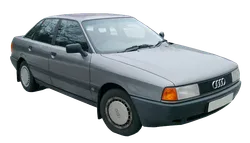

Audi 80 Generation - Audi 80 Generation 2 B1
Explore the Audi 80, particularly the Audi 80 Generation 2 B1, renowned for its design and performance. Learn more about this iconic model available in Portugal.
The Audi 80, specifically the second generation known as the B1, represents a significant chapter in the history of Audi and the automotive industry as a whole. Launched in 1972, the Audi 80 B1 was designed to cater to...
Technical Specifications
Select Version
Dimensions
Engine
Driving
Others
History and Features
Mycarro AI
Apr 26, 2025
The Audi 80, specifically the second generation known as the B1, represents a significant chapter in the history of Audi and the automotive industry as a whole. Launched in 1972, the Audi 80 B1 was designed to cater to the growing demand for compact, affordably priced sedans that offered a blend of performance, efficiency, and style. This model was pivotal for Audi, marking its emergence as a serious player in the automotive market.
Design and Features
The Audi 80 B1 featured a distinct, angular design that embodied the styling trends of the early 1970s. Its clean lines and compact proportions contributed to a sporty yet practical appearance. The introduction of the "audi" badge signified the brand's commitment to quality and performance. The car was built on the Volkswagen Group's B platform, which was shared with several other models, ensuring a good balance of manufacturing efficiency and structural integrity.
Inside, the B1 showcased a functional and driver-oriented cabin that combined comfort with a touch of luxury. Soft-touch materials and ergonomic placement of controls were new considerations for this class of car. The B1 included features that were considered advancements at the time, such as rear window defoggers and adjustable headlights. The focus on quality materials and well-thought-out design set a standard that would lead the way for future Audi models.
Engine and Performance
Audi offered a range of engines for the B1, which included both petrol and diesel options. The four-cylinder petrol engines varied in displacement, ranging from 1.3L to 1.8L, and were designed to provide a balance between performance and fuel efficiency. The diesel variant, although less common, was well-received for its durability and economy, appealing to buyers looking for cost-effective solutions.
The B1 was also one of the earliest models to feature the innovative "quattro" all-wheel-drive system, although it was not widely available during its initial release. This system would later become synonymous with Audi's branding, providing enhanced traction and stability in various road conditions. The car's handling characteristics were commendable, thanks to its well-tuned suspension that offered a smooth and engaging driving experience.
Market Reception and Legacy
Upon its release, the Audi 80 B1 garnered positive reviews from both automotive critics and the public. Its practicality combined with a sporty driving feel helped it carve out a niche in the competitive European market. The B1's appeal extended beyond just charm and usability; it became a symbol of German engineering excellence, reinforcing the perception of Audi as a manufacturer of high-quality automobiles.
Despite its success, the B1 faced stiff competition from contemporaries like the BMW 3 Series and the Mercedes-Benz 190. Audi's response was to innovate and continually enhance the model, which helped sustain interest over its production run from 1972 to 1978. By the time the B1 concluded production, it had established a formidable reputation, making way for subsequent generations and ensuring the Audi 80's status as a beloved nameplate in the automotive world.
Influence on Future Generations
The Audi 80 B1 laid the groundwork for future models in the 80 series and influenced Audi's design language for years to come. Its success demonstrated the market potential for a sporty yet practical sedan, leading Audi to refine and expand its offerings. The B1’s blend of performance, practicality, and quality served as a case study for Audi's future endeavors, paving the way for their continued growth in the automotive segment.
Conclusion
The Audi 80 Generation 2 (B1) remains a cherished model among enthusiasts and collectors. Its unique approach to design, performance, and technology encapsulated the spirit of a transformative era in automotive history. From its practical features to its spirited driving experience, the B1 holds a special place in the legacy of Audi, solidifying its reputation as a manufacturer of distinctive, high-quality vehicles. As we look back on its history, the Audi 80 B1 not only represents a singular car model but also signifies a pivotal moment in the evolution of modern automobiles.
